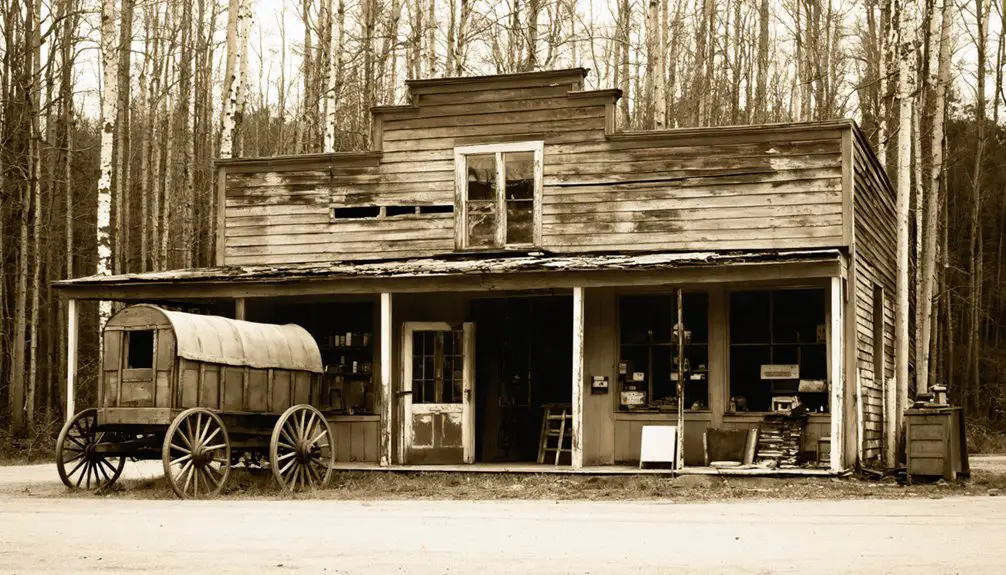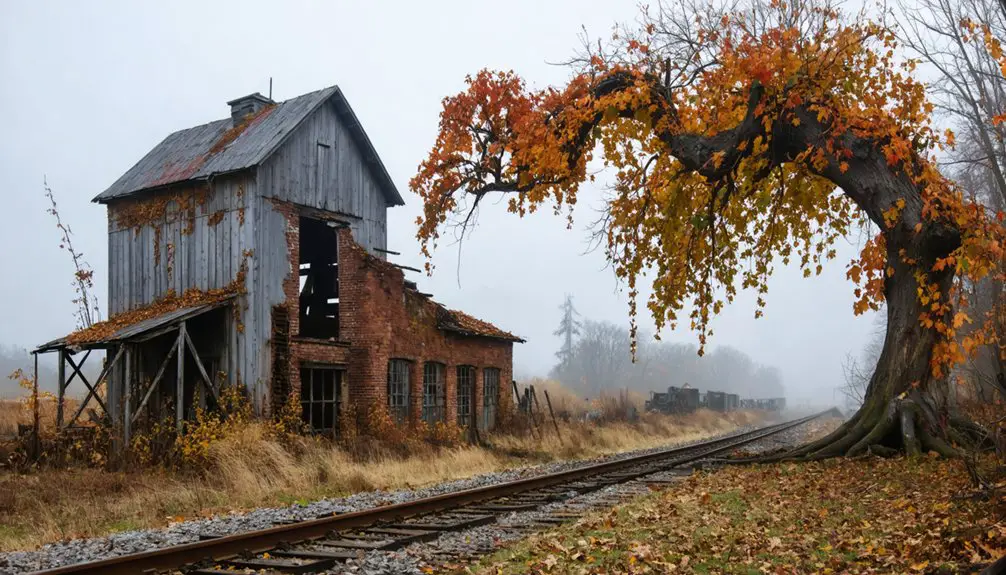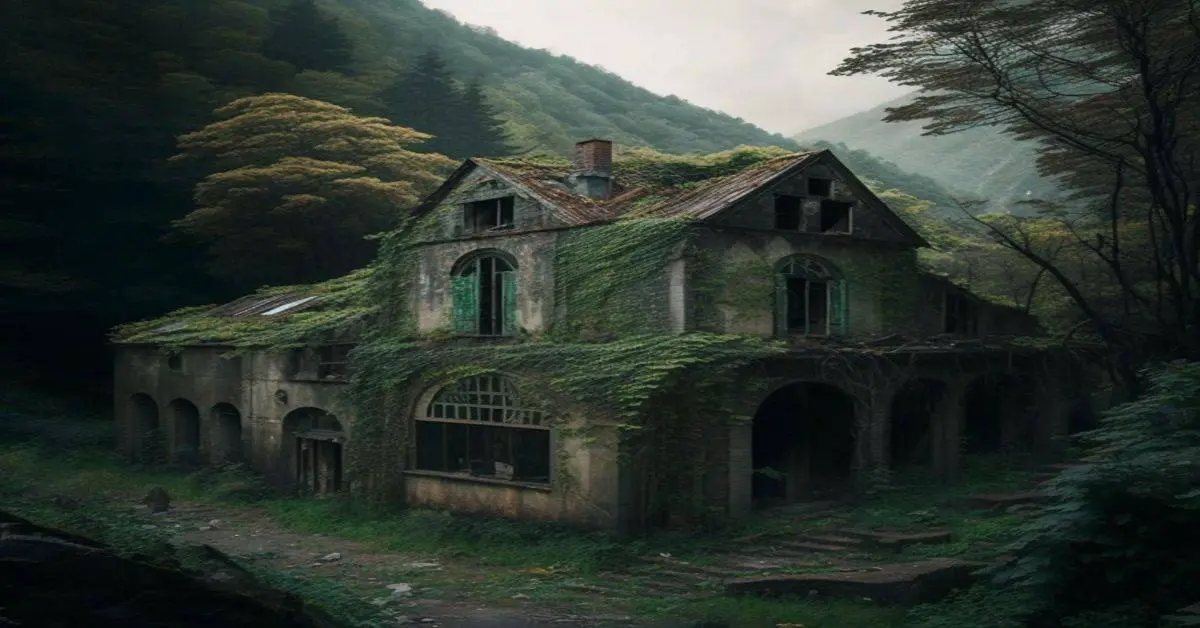You’ll find Killmaster’s ghost town remains in Alcona County, Michigan, where a bustling community of 500 once thrived during the 1880s. The settlement supported nearby mining operations with stores, smelting services, and lumber production while maintaining small farms. Today, you can explore three church ruins, a cemetery, and scattered mining equipment across the original town layout. Its story reveals fascinating connections between Michigan’s Native American heritage and industrial boom years.
Key Takeaways
- Killmaster was established in Alcona County, Michigan, with its population peaking at 500 residents during the 1880s lumber industry boom.
- The town’s economy primarily relied on lumber operations and supporting services for nearby mining communities until resources depleted.
- Archaeological findings show multiple historical layers, from 9,000-year-old indigenous settlements to 19th-century mining and lumber operations.
- Three church ruins, a cemetery, and scattered mining equipment remain as visible remnants of the once-thriving community.
- The town’s decline followed the typical boom-and-bust pattern of Michigan mining towns, driven by resource depletion and economic changes.
Origins of the Settlement
Located in Michigan’s Alcona County, Killmaster emerged from lands originally known as Negwegon County, named after an Ojibwe chief meaning “little wing.”
The area’s rich history spans thousands of years, with archaeological evidence revealing human presence dating back to 9000 BC through stone lance-heads found after the glacial retreat.
You’ll find a landscape that supported both indigenous farming and European settler experiences, with fertile soil unusual for northern Michigan.
By 1000 BC, indigenous peoples were cultivating corn, beans, and squash, leaving agricultural remnants visible to settlers who arrived in the mid-1800s.
Like Pere Cheney, the town relied heavily on railroad transportation for its early development and growth.
These pioneers faced significant community challenges, building temporary shelters and adapting to frontier isolation.
The settlement grew alongside other communities in the 1860s, as immigrant groups sought opportunities in the region’s abundant forests and farmland.
The area became more established in 1869 when it was officially organized as Alcona County, marking a new chapter in its development.
Early Economic Activities
While copper mining dominated much of Michigan’s Upper Peninsula, Killmaster’s economic foundation rested primarily on supporting industries that served the region’s mining communities.
You’d find bustling supply stores, general merchants, and smelting services that kept the dangerous copper extraction operations running smoothly. Despite the mining hazards, workers streamed into the area, transforming Killmaster into a thriving company town. Native Americans in the area had originally used local copper deposits for crafting tools and jewelry before industrial mining began.
Despite harsh mining conditions, Killmaster flourished as workers flocked to its busy shops and smelting operations.
The settlement’s economy diversified through lumber operations, which provided essential materials for mining infrastructure and buildings. Many ghost town remnants today serve as popular tourist attractions throughout Michigan.
Local residents also maintained small farms growing corn, beans, and squash, while supplementing their income through hunting and fishing. Together, these interconnected activities created a web of commerce that sustained Killmaster during its peak years, though this prosperity wouldn’t last forever.
Native American Heritage
Long before European settlers established Killmaster, indigenous peoples had cultivated this land for thousands of years.
You’ll find evidence of their presence dating back to 9000 BC, when they left stone lance-heads near what would later become Killmaster.
The area’s rich heritage stems from Ojibwe traditions, with the region originally named Negwegon County after an Ojibwe chief.
Indigenous agriculture flourished here, with Native Americans growing corn, beans, and squash.
When European trappers arrived around 1845, they discovered ancient corn hills still visible across the landscape – a confirmation to generations of careful land management.
Archaeological findings reveal how Native communities shifted from nomadic lifestyles to established farming practices, making full use of the abundant hunting and fishing grounds that sustained their communities.
Rise and Fall of Industries
In northern Michigan, you’ll find that Killmaster’s economic fortunes rose with the logging industry’s surge in the late 19th century, when the population reached around 500 people at its peak in the 1880s.
Like many towns in oil and gas operations today, Killmaster adapted to changing natural resource demands over time.
Your understanding of the town’s development would note that it centered around lumber operations, with essential services like hotels, general stores, and post offices emerging to support the growing workforce.
The town’s eventual decline mirrors many similar communities in the region, as resource depletion and technological changes in logging practices led to decreased economic viability and population loss. This pattern of boom and bust was similar to Michigan’s first copper mining boom in 1844, which generated more wealth than the California gold rush.
Lumber Trade Boom
During Michigan’s golden age of lumber from 1869 to 1900, the state dominated America’s timber industry, becoming the nation’s leading producer of lumber products.
You’d have witnessed massive logging operations spreading across the state, including areas like Killmaster before it became a ghost town. Lumber camps sprung up in remote regions, where workers toiled under harsh conditions to feed the growing demand from expanding cities like Detroit and Chicago. Timber cruisers ventured deep into the forests to survey and mark the best plots for harvest.
The industry transformed communities across Michigan, powering the growth of towns like Grayling, Manistee, Muskegon, and Alpena. Lumber wasn’t just for construction – it supplied essential materials for shipbuilding, mining operations, and iron smelting. The massive white pines harvested during this era typically reached 4 feet in diameter, providing abundant material for construction projects.
Even Ford Motor Company joined the lumber trade, controlling over 500,000 acres in the Upper Peninsula at its peak.
Economic Crisis Impact
Mining’s rise and fall profoundly shaped Killmaster’s destiny, mirroring the economic volatility that swept through Michigan’s Upper Peninsula in the late 19th and early 20th centuries.
You’ll find that as mineral deposits depleted and copper prices fluctuated, the region’s economic resilience weakened dramatically. The crisis hit hard – mines shut down, triggering widespread community migration as workers and their families sought opportunities elsewhere.
Local businesses that once thrived on mining activity couldn’t survive the population exodus. Stores closed, schools emptied, and services disappeared. Similar to Baltic Mining Company, the area produced substantial mineral wealth before its eventual decline. The industry’s dangers became evident when ten miners died in a devastating accident that accelerated the area’s downturn.
While some residents tried to rely on farming and rural industries, the harsh climate and limited agricultural potential couldn’t fill the economic void. Even attempts to diversify the economy came too late, leaving Killmaster to join the ranks of Michigan’s ghost towns.
Life in Early Killmaster

Life in early Killmaster centered around your daily farming routines, where you’d work from dawn to dusk tending crops and livestock in the region’s uniquely fertile soil.
You’d gather with neighbors at the local church for Sunday services and social events, while the township hall hosted community meetings and celebrations that strengthened local bonds.
The general store served as your primary trading hub, where you’d barter farm goods and acquire essential supplies while catching up on local news and sharing stories with fellow residents.
Daily Agricultural Routines
As dawn broke over early Killmaster’s fertile fields, farmers would begin their daily routines with livestock care and equipment preparation.
You’d find yourself following the rhythms of the seasons, tending to daily chores from sunup to sundown. Working with traditional hand tools, you’d clear fields, plant crops, and maintain the farmstead alongside your neighbors.
Crop preservation became essential as winter approached, with careful attention to drying and storing harvests in community granaries.
- Rise before sunrise to feed and water livestock
- Work the fields using horse-drawn plows and manual implements
- Practice indigenous-inspired farming with corn, beans, and squash
- Collaborate with neighbors during labor-intensive seasons
- Preserve autumn harvests through drying and careful storage for winter months
Social Gatherings and Events
Despite Killmaster’s remote location, the town’s social fabric thrived through vibrant community gatherings that punctuated daily rural life. You’d find seasonal festivals marking planting and harvest times, while religious services brought neighbors together in local churches.
Community celebrations often featured shared meals, music, and dancing, with fiddles and guitars setting the mood for evening entertainment.
The schoolhouse served multiple roles, hosting plays, lectures, and cultural traditions that blended Indigenous and settler influences. You could join hunting trips that doubled as social outings, or attend community picnics near forests and lakes.
The town’s gathering spots – from general stores to post offices – created natural hubs where you’d exchange news and strengthen bonds through storytelling, crafts, and folk art activities.
Local Trade and Commerce
Trade in early Killmaster centered around the town’s natural bounty, with logging operations and agricultural ventures forming the economic backbone of the community.
You’d find locals exchanging goods through barter systems at general stores, where seasonal trade flourished during harvest and logging peaks. River routes and winter sleds helped move commodities to larger markets, despite rudimentary road conditions limiting commerce reach.
- Local farmers traded corn, beans, and squash cultivated from the region’s fertile soil
- Company stores served as crucial hubs for exchanging essential supplies
- Blacksmiths and wagon repair shops kept logging and farming equipment operational
- Fish from nearby lakes supplemented both sustenance and trade goods
- Post offices and telegraph stations facilitated critical business communications
Archaeological Discoveries
While the Killmaster region now stands as a ghost town, its archaeological significance spans thousands of years of human history.
You’ll find evidence of prehistoric habitation dating back to 9,000 BC, with stone lance-heads scattered throughout Alcona County. The area’s rich heritage includes ancient agricultural practices, with remnants of corn hills persisting into the 19th century.
Perhaps the most remarkable discovery lies beneath Lake Huron’s surface, where submerged archaeology has revealed a 9,000-year-old caribou hunting structure just 35 miles southeast of Alpena.
More recent findings from the ghost town itself include coal mining relics, period-specific buckles, and porcelain door knobs unearthed through metal detecting along the riverbeds, painting a vivid picture of daily life in this once-bustling mining community.
Surviving Structures and Ruins
Hidden beneath the encroaching forest and marshy terrain, Killmaster’s surviving structures tell the story of a once-thriving mining community.
You’ll find the remnants of three churches and a cemetery, alongside scattered foundations of homes built from local timber and stone. These historical artifacts paint a picture of 19th-century frontier life, where miners carved out their existence in Michigan’s rugged landscape.
- Three church ruins and a cemetery remain as the most prominent features
- Rough-cut timber and stone foundations reveal period construction methods
- Rusted mining equipment and domestic items scatter the grounds
- Building clusters follow original town layout along former main streets
- Remote locations require off-trail exploration to access most ruins
The ruins exploration can be challenging, as nature reclaims these relics of Killmaster’s industrial past through seasonal marsh conditions and dense forest growth.
Legacy in Michigan’s History
Beyond its physical remains, Killmaster stands as a tribute to Michigan’s dynamic lumbering heritage.
Michigan’s logging legacy lives on through Killmaster, a testament to the state’s rich forestry history.
You’ll find its cultural significance woven into the broader tapestry of Michigan’s resource-driven communities, from its origins as a self-sufficient logging town to its eventual decline as timber resources depleted.
The town’s historical preservation efforts, including the seasonal operation of Killmaster Soapworks, keep alive the memory of a once-thriving community that boasted a doctor, lawyers, and various businesses.
The area’s rich history extends far beyond the lumber era, with archaeological evidence revealing Native American presence dating back to 9000 BC.
Through Killmaster’s story, you’ll understand how Michigan’s early towns rose and fell with the ebb and flow of natural resource exploitation.
Frequently Asked Questions
What Paranormal Activities or Ghost Stories Are Associated With Killmaster?
You’ll encounter ghost sightings at these haunted locations, including shadowy figures, mysterious footsteps, cold spots, unexplained voices, and equipment malfunctions. Local legends tell of weeping women and phantom train lights.
How Can Visitors Safely Access and Explore the Killmaster Site Today?
You can access the site via Cruzen Road off F-30, but there aren’t guided tours. Take safety precautions: bring GPS, inform others, respect private property, and stay visible.
Are There Any Annual Events or Festivals Celebrating Killmaster’s History?
You won’t find dedicated annual events or historical reenactments for this site. Unlike other ghost towns, there aren’t any organized festivals or local folklore celebrations currently preserving its heritage.
What Happened to the Residents After They Abandoned Killmaster?
Like scattered seeds in the wind, you’ll find the residents spread to nearby towns like Harrisville, seeking work in farming, fishing, and logging while carrying Killmaster’s legacy to their new communities.
Where Can People Find Historical Photographs or Maps of Killmaster?
You’ll find historical photographs and old maps by visiting Northern Michigan University’s archives, connecting with Alcona County historical societies, or accessing digital collections maintained by local museums and libraries.
References
- https://www.nailhed.com/2014/12/a-hole-in-forest.html
- https://www.visitkeweenaw.com/things-to-do/museums-history/ghost-towns/
- https://www.youtube.com/watch?v=6wxzbfrg_Qo
- https://www.youtube.com/watch?v=7-vjuqiGWJU
- https://en.wikipedia.org/wiki/List_of_ghost_towns_in_Michigan
- https://northernmichiganhistory.com/pere-cheney-michigans-legendary-ghost-town/
- https://www.nps.gov/slbe/learn/historyculture/ghosttowns.htm
- https://gandernewsroom.com/2022/10/28/the-story-behind-6-ghost-towns-in-michigan-that-are-worth-exploring/
- https://www.clickondetroit.com/features/2023/10/17/the-story-of-michigans-most-infamous-ghost-town/
- http://focusingontravel.blogspot.com/2018/03/keen-on-keweenaw-county-ghost-towns.html


